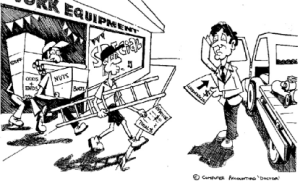Percentages tell you much more about your business than numbers ever could. One business man, who recently sold a sand haulage business told us how the simple concept of focusing on percentages changed his whole future and was in a large part responsible for his success:
“I used to read the numbers my accountant gave me,” said the owner of a $2.8 million dollar business, “and it drove me crazy. I knew we were improving, but I wasn’t sure how well we were managing costs, relative to the growing sales.
“Fortunately I had a good accountant. He suggested he add percentages against all the costs and income on the Profit & Loss, so I’d know if we were up or down at a glance.
“It was like someone turned the light on!”
“I knew instantly how well one set of figures compared against the previous one without even looking at the numbers.”
“Cost of Goods Sold”, commonly abbreviated to COGS%, simply means the costs you incur to get the product or service to the customer, before taking into account your day-to-day operational costs or overheads.
(They are also called “Direct Costs or Variable Costs.”)
This is a really important number as it has a huge impact on your Gross Profit … and an even bigger one on your Net Profit.
Many business owners focus a lot of attention on Revenue, but a small reduction in COGS%* can have as much impact on Gross Profit as a large increase in Revenue. Understanding what makes up your COGS, and some negotiation or investigation with suppliers for better prices, can make a big difference.
If you are a service based business, pay attention to work practices and job management, as these can have the same effect on your Gross Profit. This provides an opportunity to investigate differences and tighten up processes. An example of this is knowing:
How many labour hours you are selling … compared to those you are paying for!
Too many ‘unbillable hours’ could be costing thousands of dollars when you multiply them by your charge out rate.
Most basic accounting systems have a rudimentary job costing system, but if your business does “jobs” and contracts out labour, then we suggest you get dedicated job-costing software that links with your accounting system.
It seems obvious why you would want to decrease costs in business, but many will not appreciate how big an impact this can have on the bottom line.
Every dollar you save on your COGS … goes straight to the bottom line.
There are generally two types of costs in business, being Direct Costs or COGS (Cost of Goods Sold) and Indirect Costs or Overheads. COGS are sometimes referred to as COS or Cost of Sales.
The difference between COGS and Overheads is that COGS only occur when you sell something, whereas Overheads occur whether you make a sale or not. For example Rent is an overhead, as this has to be paid whether you make a sale or not, whereas purchase of stock or paying service providers, only occurs when you sell something.
It is important to differentiate between COGS and Overheads, because every business needs to know what its gross profit is. Gross Profit is calculated by subtracting the COGS from the Income figure.
It’s a vital indicator of business performance for both managers and lenders. Gross Profit is also an important benchmark against which to measure your business… to others in its industry.
So what types of costs are classified as COGS?
-
- Purchase of stock to sell
-
- Movement in stock held i.e. what was held at the beginning of an accounting period versus what was held at the end of the period.
-
- Freight costs to get goods into and out of stock.
-
- Labour costs relating to production of a service or product.
-
- Importing costs e.g. duties etc.
-
- Discounts given
-
- Stock adjustments/Stock wastage
-
- Purchase returns and allowances
-
- Raw materials
-
- Manufacturing costs
-
- Packaging
-
- Other costs to get goods or services ready for sale.
COGS are often the most sensitive of the ‘Key Financial Numbers’ in relation to both profit and cash flow results.
It’s possible, in some circumstances, to create a larger increase in profit, by reducing COGS by a small percentage, rather than increasing sales by a large one.
This is because when sales grow, generally other numbers grow too, such as COGS and Overheads.
Also an increase in sales creates a need for more ‘working capital’ to fund your suppliers, additional inventory and ‘Work In Progress’ … but a reduction in COGS does not!
The reduction goes straight to your bottom line!
If you’re in a service business don’t think that COGS doesn’t relate to you because you don’t sell products. A factor in COGS for a service business is ‘Work in Progress’ (WIP). Many service businesses have no real methodology for handling WIP or Jobs.
We once asked a contractor:
“How often do you do your invoicing to customers?” and the answer: “When I run out of money!”
Ensure jobs get invoiced out as quickly as possible.
By doing so you’ll speed up payment. There are systems available that easily speed up WIP and jobs, and the resulting improvement in profit and cash flow can be significant.
Budgeting for COGS will help you monitor profitability. COGS can very easily ‘creep up’ without you realising it.
These increased costs need to be passed onto customers regularly, or they erode profit margins.
Keeping track of such costs may seem like a pain, but the resulting control over margins and profitability, far outweighs the cost of maintaining such control.
Here are eight ways to reduce your COGS:
-
- Reduce wastage: Reduce materials used on jobs by managing wastage and write offs. Review ordering methods and introduce systems such as job cost sheets to track goods used on jobs.
-
- Increasing productivity: Maximise efficiency of contractors and staff e.g. check any ‘non chargeable’ time spent. Incentivise staff by sharing the savings. It may be that some work can be outsourced, even overseas. This could free up a more costly person to focus on more chargeable work.
-
- Review and negotiate with suppliers: It’s easy to get into a ‘rut’ and deal with the same old suppliers and do things in the same old way. Technology has opened up all kinds of opportunities to improve efficiency.
-
- Innovate: Look for innovative ways to change the way you perform processes. Research your industry to find out what new ideas are available. Create a ‘one-small-improvement-a-week’ policy.
-
- Industry benchmarks: Check to see what the top performers are achieving. Benchmarks for your industry/business could be available online.
-
- Exchange rates: Lock in good exchange rates with forward cover on foreign currencies.
-
- Manage your margins: Regularly looking at the percentage of Cost of Goods, so that you know when is the right time to renegotiate or look for alternatives.
-
- Use ‘Purchase Orders’: Don’t just allow anyone in the business to spend your money. One piece of paper in the form of a purchase order could save you thousands of dollars. The person ordering goods or services may not know something you know about a change or potential obsolescence.
Note: In our QuickCall business example shown earlier – 1% decrease added $9,872 to the bottom line!
| *Cost of Goods Sold Percentage%
This is the percentage of Cost of Goods Sold compared to Revenue Example Revenue $1,000,000 Cost of Goods Sold $ 700,000 700,000 / 1,000,000 x 100 = 70% |
Look out for our next blog post for more detailed information about each of the Seven Key Numbers and ways to improve them.
If you don’t want to wait for the next blog post and you’re keen to get started improving your Seven Key Numbers right now… Download our eBook ‘The Seven Key Numbers that Drive Profit and Cash Flow’






